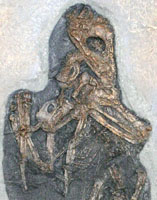Confuciusornis sanctus ("the sacred bird of Confucius") is the earliest known beaked bird. Discovered in 1994, Confuciusornis represents an important side branch in avian evolution. Though Confuciusornis and its descendants all became extinct, it is the earliest known bird to abandon its reptilian teeth in favor of a light-weight keratin beak.
Remains of Confuciusornis are found at an Early Cretacaeous fossil site known as Sihetun in the Liaoning Province of northeastern China. About 125 million years ago, Sihetun was an ancient freshwater lake that supported many fish, invertebrates, mammals, dinosaurs, and primitive birds. A nearby volcano blast killed and buried the inhabitants of the lake in a 4,800 foot thick layer of claystone. The fine grain of the claystone and the rapid burial of the animals there allowed exceptional preservation of the soft parts of these animals such as internal organs and feathers.
By studying the well preserved remains of Confuciusornis specimens from Sihuten, much can be determined about its lifestyle and adaptations. Confuciusornis seems to have been an apt flyer, having well developed flight feathers and hollow bones as a weight-saving feature. Unlike most modern birds Confuciusornis retained clawed fingers on its wings. The feet, with strong recurved claws seem to have been adapted for perching. Because hundreds of specimens have been found at Sihuten, it is assumed that Confuciusornis colonized along the lake, perhaps for nesting or mating. Because of its evolutionary significance and exceptional preservation, Confuciusornis is a highly significant fossil. The specimen represented here is a female. Males had long tail feathers, similar to today's Central American Quetzal.
Specimens of Confuciusornis sanctus of this quality have been offered for sale between $16,000.00 and $18,000.00.
Confuciusornis sanctus 
Quantity in Basket: None
Code: AVE-200
Price: $216.50
Shipping Weight: 1.67 pounds
Time: Early Cretaceous Period approximately 125 million years ago.
Location: Yixian Formation, Sihetun, Liaoning Province, China
Dimensions: 14-3/4" x 9-1/2" x 1"